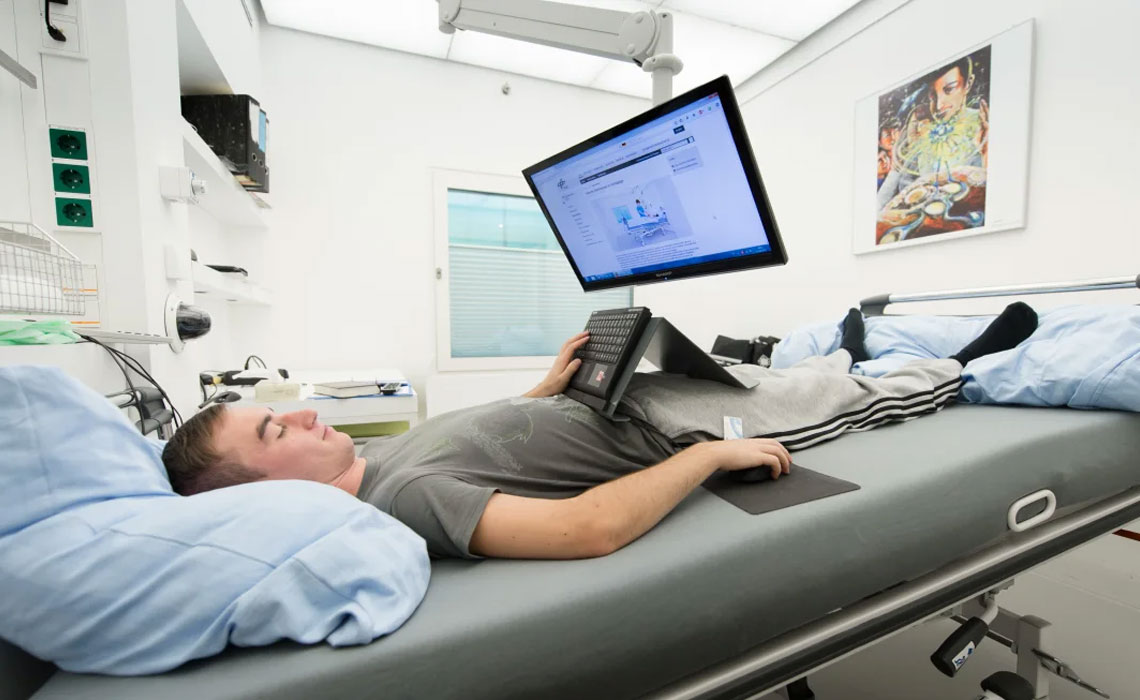Space flights, 60 days of head down bed rest, astronauts' sensitive feet and balance impairments
From astronauts to pillownauts, an MRU biologist is studying skin sensitivity changes in participants spending 60 days in head down bed rest to better understand sensory adaptations that occur during space flight.
Dr. Nick Strzalkowski, PhD, is part of a team studying countermeasures that could help astronauts deal with these issues in future while providing valuable learnings for humans on Earth.
Strzalkowski is cross appointed in the Departments of Biology and General Education, and teaches courses on numeracy and scientific literacy, as well as human physiology. His scientific interests cover all aspects of human health, but specifically the neural pathways and networks involved in the control of movement in healthy and diseased populations.
At University of Guelph, Strzalkowski obtained a PhD under the supervision of Dr. Leah Bent, PhD, who studies neurophysiology and is the primary investigator in this latest project funded by the Canadian Space Agency.
Part of that graduate research involved a 2009 project called Hypersole. For this project Strzalowski and Bent looked at the sensitivity of the skin on astronauts' feet before and after a short space flight to the International Space Station.
Skin receptors in the sole of the foot play a critical role in the control of balance and posture, and tactile skin feedback provides humans with information about the direction of gravity and body orientation and verticality. The subjects of the original Hypersol study were 11 crew from the last four space shuttle missions before the space shuttle program was cancelled in 2011.
“That’s how I got started in space research. We worked with astronauts, I got to travel all over the States, and it led to two publications,” says Strzalkowski.
In particular, the study identified a subgroup of astronauts who demonstrated increased sensitivity of skin receptors that was shown to correspond to balance impairments following space flight, during trials specifically designed to target vestibular system (inner ear) deficits.
The current research, Hypersole2, will be conducted in collaboration with NASA and DLR (German space agency), and is one of many concurrent projects run at :envihab in Cologne, Germany. The experiment Strzalkowski is contributing to involves 60 days of head down bed rest — an established space flight analog. Participants remain in a bed with their head tilted below their feet by six degrees, simulating the physiological onloading and fluid shifts experienced by astronauts in microgravity. Participants will have nursing and physiotherapy care, but will otherwise stay lying down for the duration of the study. With access to computers and screens, many participants in similar studies take courses, play games and watch movies to fill the time.
“For our study they will be lying on their stomach, " says Strzalkowski. “Sixty days is enough to see the effects on the muscle and bone that you probably wouldn’t see over a week.”

Participants are divided into four groups: control, proprioceptive training (involving body awareness), electrical muscle stimulation, and exercise. The goal is to see if these countermeasures have an impact on skin sensitivity and if that may lessen the impact of long voyages in space.
“When you go up in space, you’re floating, and one thing that happens is your vestibular system, which normally tells us about gravity, gets disrupted. Your brain kind of freaks out, you get really nauseous for a few days, but then over time we think there’s a re-weighting of sensory feedback to compensate and one of those things could be more sensitive skin because our skin also tells us about gravity here on earth when we’re standing,” Strzalkowski explains.
“For me, being part of something this enormous is really interesting. A lot of the work we do is often just ourselves in the lab. This project involves dozens of labs and even our team has three faculty researchers involved and we’re one tiny piece of this.”
The work will also involve MRU undergraduate students in data analysis, an important component of research and the undergraduate experience at MRU.
"Nick's work in this area emphasizes the wide range of research that is happening at MRU. As we increase our research capabilities, the sky isn't even the limit for faculty and for our students,” said Dr. Jonathan Withey, DPhil, Dean of Science and Technology at MRU.
While the immediate goal is to find ways to help astronauts, the research findings have potential spinoffs for human health here on earth.
“There are people who are bedridden so it will help with that, but it’s bigger than that,” Strzalkowski stresses. “It involves a lot of basic science questions about human physiology. Learning about these intervention and mitigation strategies might turn into spinoff therapies for different patients or population groups. It’s pretty amazing how much space research makes its way back to the public.”

